FIAT BRAVO 2013 2.G Owners Manual
Manufacturer: FIAT, Model Year: 2013, Model line: BRAVO, Model: FIAT BRAVO 2013 2.GPages: 299, PDF Size: 5.86 MB
Page 111 of 299
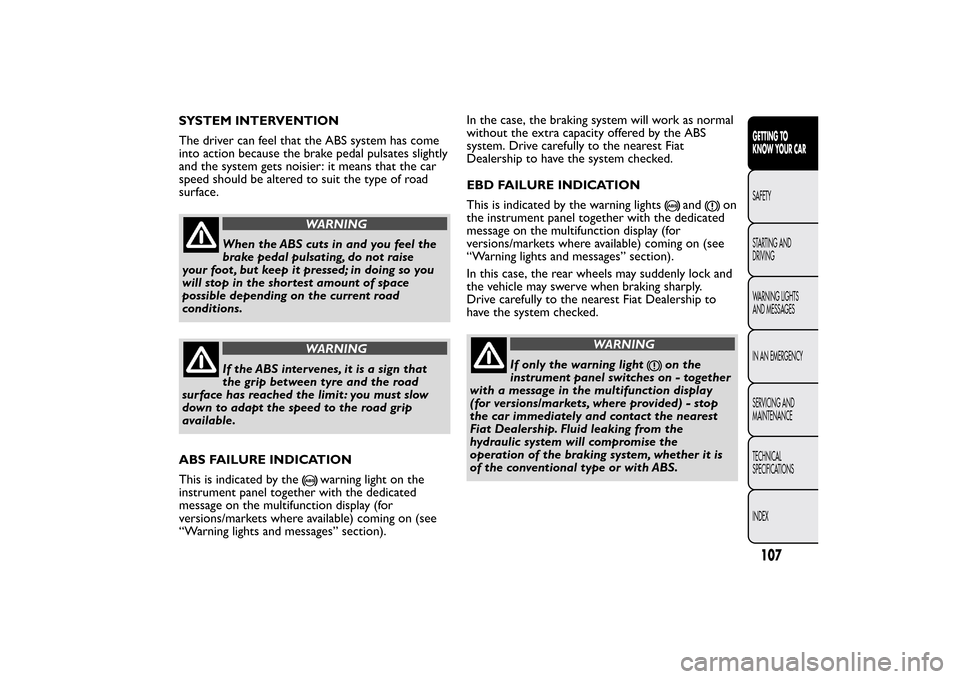
SYSTEM INTERVENTION
The driver can feel that the ABS system has come
into action because the brake pedal pulsates slightly
and the system gets noisier: it means that the car
speed should be altered to suit the type of road
surface.
WARNING
When the ABS cuts in and you feel the
brake pedal pulsating, do not raise
your foot , but keep it pressed; in doing so you
will stop in the shortest amount of space
possible depending on the current road
conditions.
WARNING
If the ABS intervenes, it is a sign that
the grip between tyre and the road
surface has reached the limit : you must slow
down to adapt the speed to the road grip
available.
ABS FAILURE INDICATION
This is indicated by the
warning light on the
instrument panel together with the dedicated
message on the multifunction display (for
versions/markets where available) coming on (see
“Warning lights and messages” section).In the case, the braking system will work as normal
without the extra capacity offered by the ABS
system. Drive carefully to the nearest Fiat
Dealership to have the system checked.
EBD FAILURE INDICATION
This is indicated by the warning lights
and
on
the instrument panel together with the dedicated
message on the multifunction display (for
versions/markets where available) coming on (see
“Warning lights and messages” section).
In this case, the rear wheels may suddenly lock and
the vehicle may swerve when braking sharply.
Drive carefully to the nearest Fiat Dealership to
have the system checked.
WARNING
If only the warning light
on the
instrument panel switches on - together
with a message in the multifunction display
(for versions/markets, where provided) - stop
the car immediately and contact the nearest
Fiat Dealership. Fluid leaking from the
hydraulic system will compromise the
operation of the braking system, whether it is
of the conventional type or with ABS.
107GETTING TO
KNOW YOUR CARSAFETY
STARTING AND
DRIVING
WARNING LIGHTS
AND MESSAGES
IN AN EMERGENCY
SERVICING AND
MAINTENANCE
TECHNICAL
SPECIFICATIONS
INDEX
Page 112 of 299
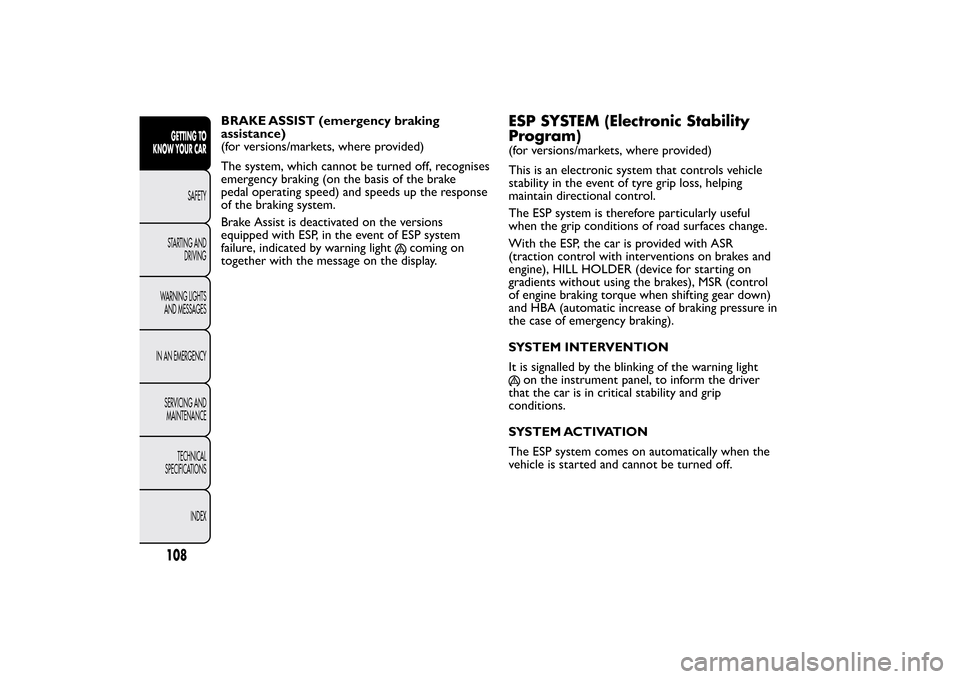
BRAKE ASSIST (emergency braking
assistance)
(for versions/markets, where provided)
The system, which cannot be turned off, recognises
emergency braking (on the basis of the brake
pedal operating speed) and speeds up the response
of the braking system.
Brake Assist is deactivated on the versions
equipped with ESP, in the event of ESP system
failure, indicated by warning light
coming on
together with the message on the display.
ESP SYSTEM (Electronic Stability
Program)(for versions/markets, where provided)
This is an electronic system that controls vehicle
stability in the event of tyre grip loss, helping
maintain directional control.
The ESP system is therefore particularly useful
when the grip conditions of road surfaces change.
With the ESP, the car is provided with ASR
(traction control with interventions on brakes and
engine), HILL HOLDER (device for starting on
gradients without using the brakes), MSR (control
of engine braking torque when shifting gear down)
and HBA (automatic increase of braking pressure in
the case of emergency braking).
SYSTEM INTERVENTION
It is signalled by the blinking of the warning light
on the instrument panel, to inform the driver
that the car is in critical stability and grip
conditions.
SYSTEM ACTIVATION
The ESP system comes on automatically when the
vehicle is started and cannot be turned off.
108GETTING TO
KNOW YOUR CAR
SAFETY
STARTING AND
DRIVING
WARNING LIGHTS
AND MESSAGES
IN AN EMERGENCY
SERVICING AND
MAINTENANCE
TECHNICAL
SPECIFICATIONS
INDEX
Page 113 of 299
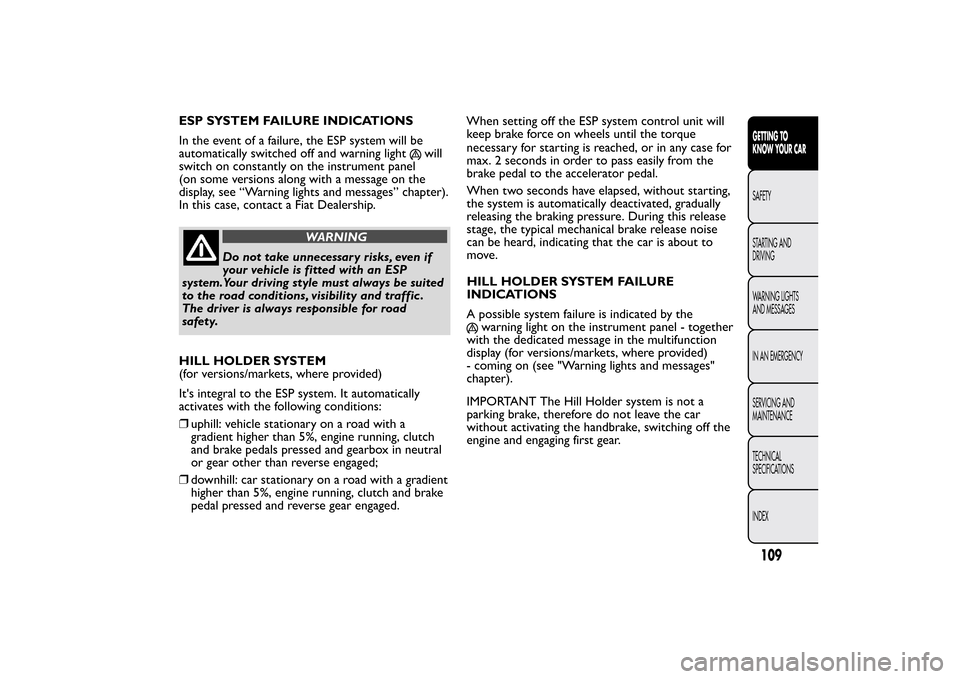
ESP SYSTEM FAILURE INDICATIONS
In the event of a failure, the ESP system will be
automatically switched off and warning light
will
switch on constantly on the instrument panel
(on some versions along with a message on the
display, see “Warning lights and messages” chapter).
In this case, contact a Fiat Dealership.
WARNING
Do not take unnecessary risks, even if
your vehicle is fitted with an ESP
system.Your driving style must always be suited
to the road conditions, visibility and traffic .
The driver is always responsible for road
safety.
HILL HOLDER SYSTEM
(for versions/markets, where provided)
It's integral to the ESP system. It automatically
activates with the following conditions:
❒uphill: vehicle stationary on a road with a
gradient higher than 5%, engine running, clutch
and brake pedals pressed and gearbox in neutral
or gear other than reverse engaged;
❒downhill: car stationary on a road with a gradient
higher than 5%, engine running, clutch and brake
pedal pressed and reverse gear engaged.When setting off the ESP system control unit will
keep brake force on wheels until the torque
necessary for starting is reached, or in any case for
max. 2 seconds in order to pass easily from the
brake pedal to the accelerator pedal.
When two seconds have elapsed, without starting,
the system is automatically deactivated, gradually
releasing the braking pressure. During this release
stage, the typical mechanical brake release noise
can be heard, indicating that the car is about to
move.
HILL HOLDER SYSTEM FAILURE
INDICATIONS
A possible system failure is indicated by the
warning light on the instrument panel - together
with the dedicated message in the multifunction
display (for versions/markets, where provided)
- coming on (see "Warning lights and messages"
chapter).
IMPORTANT The Hill Holder system is not a
parking brake, therefore do not leave the car
without activating the handbrake, switching off the
engine and engaging first gear.
109GETTING TO
KNOW YOUR CARSAFETY
STARTING AND
DRIVING
WARNING LIGHTS
AND MESSAGES
IN AN EMERGENCY
SERVICING AND
MAINTENANCE
TECHNICAL
SPECIFICATIONS
INDEX
Page 114 of 299
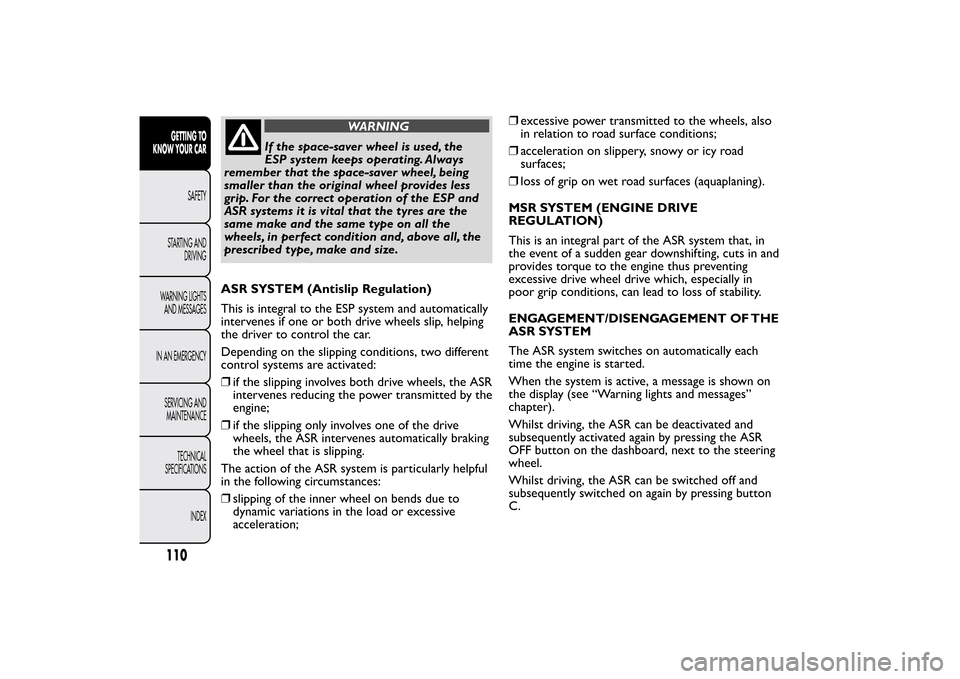
WARNING
If the space-saver wheel is used, the
ESP system keeps operating. Always
remember that the space-saver wheel, being
smaller than the original wheel provides less
grip. For the correct operation of the ESP and
ASR systems it is vital that the tyres are the
same make and the same type on all the
wheels, in perfect condition and, above all, the
prescribed type, make and size.
ASR SYSTEM (Antislip Regulation)
This is integral to the ESP system and automatically
intervenes if one or both drive wheels slip, helping
the driver to control the car.
Depending on the slipping conditions, two different
control systems are activated:
❒if the slipping involves both drive wheels, the ASR
intervenes reducing the power transmitted by the
engine;
❒if the slipping only involves one of the drive
wheels, the ASR intervenes automatically braking
the wheel that is slipping.
The action of the ASR system is particularly helpful
in the following circumstances:
❒slipping of the inner wheel on bends due to
dynamic variations in the load or excessive
acceleration;❒excessive power transmitted to the wheels, also
in relation to road surface conditions;
❒acceleration on slippery, snowy or icy road
surfaces;
❒loss of grip on wet road surfaces (aquaplaning).
MSR SYSTEM (ENGINE DRIVE
REGULATION)
This is an integral part of the ASR system that, in
the event of a sudden gear downshifting, cuts in and
provides torque to the engine thus preventing
excessive drive wheel drive which, especially in
poor grip conditions, can lead to loss of stability.
ENGAGEMENT/DISENGAGEMENT OF THE
ASR SYSTEM
The ASR system switches on automatically each
time the engine is started.
When the system is active, a message is shown on
the display (see “Warning lights and messages”
chapter).
Whilst driving, the ASR can be deactivated and
subsequently activated again by pressing the ASR
OFF button on the dashboard, next to the steering
wheel.
Whilst driving, the ASR can be switched off and
subsequently switched on again by pressing button
C.
110GETTING TO
KNOW YOUR CAR
SAFETY
STARTING AND
DRIVING
WARNING LIGHTS
AND MESSAGES
IN AN EMERGENCY
SERVICING AND
MAINTENANCE
TECHNICAL
SPECIFICATIONS
INDEX
Page 115 of 299
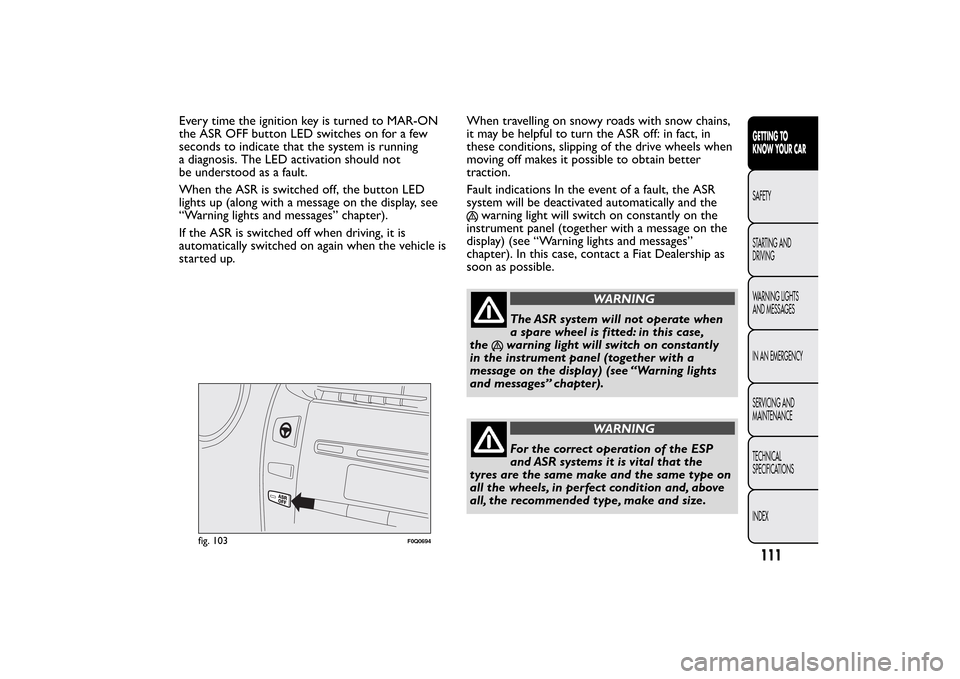
Every time the ignition key is turned to MAR-ON
the ASR OFF button LED switches on for a few
seconds to indicate that the system is running
a diagnosis. The LED activation should not
be understood as a fault.
When the ASR is switched off, the button LED
lights up (along with a message on the display, see
“Warning lights and messages” chapter).
If the ASR is switched off when driving, it is
automatically switched on again when the vehicle is
started up.When travelling on snowy roads with snow chains,
it may be helpful to turn the ASR off: in fact, in
these conditions, slipping of the drive wheels when
moving off makes it possible to obtain better
traction.
Fault indications In the event of a fault, the ASR
system will be deactivated automatically and the
warning light will switch on constantly on the
instrument panel (together with a message on the
display) (see “Warning lights and messages”
chapter). In this case, contact a Fiat Dealership as
soon as possible.
WARNING
The ASR system will not operate when
a spare wheel is fitted: in this case,
thewarning light will switch on constantly
in the instrument panel (together with a
message on the display) (see “Warning lights
and messages” chapter).
WARNING
For the correct operation of the ESP
and ASR systems it is vital that the
tyres are the same make and the same type on
all the wheels, in perfect condition and, above
all, the recommended type, make and size.
fig. 103
F0Q0694
111GETTING TO
KNOW YOUR CARSAFETY
STARTING AND
DRIVING
WARNING LIGHTS
AND MESSAGES
IN AN EMERGENCY
SERVICING AND
MAINTENANCE
TECHNICAL
SPECIFICATIONS
INDEX
Page 116 of 299
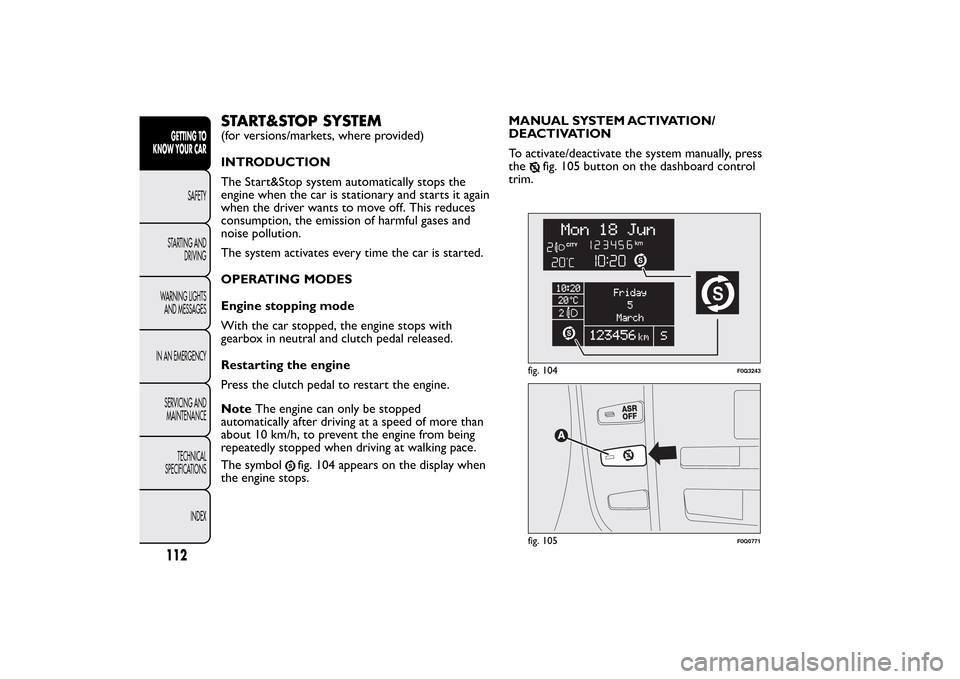
START&STOP SYSTEM(for versions/markets, where provided)
INTRODUCTION
The Start&Stop system automatically stops the
engine when the car is stationary and starts it again
when the driver wants to move off. This reduces
consumption, the emission of harmful gases and
noise pollution.
The system activates every time the car is started.
OPERATING MODES
Engine stopping mode
With the car stopped, the engine stops with
gearbox in neutral and clutch pedal released.
Restarting the engine
Press the clutch pedal to restart the engine.
NoteThe engine can only be stopped
automatically after driving at a speed of more than
about 10 km/h, to prevent the engine from being
repeatedly stopped when driving at walking pace.
The symbol
fig. 104 appears on the display when
the engine stops.MANUAL SYSTEM ACTIVATION/
DEACTIVATION
To activate/deactivate the system manually, press
the
fig. 105 button on the dashboard control
trim.
fig. 104
F0Q3243
fig. 105
F0Q0771
112GETTING TO
KNOW YOUR CAR
SAFETY
STARTING AND
DRIVING
WARNING LIGHTS
AND MESSAGES
IN AN EMERGENCY
SERVICING AND
MAINTENANCE
TECHNICAL
SPECIFICATIONS
INDEX
Page 117 of 299
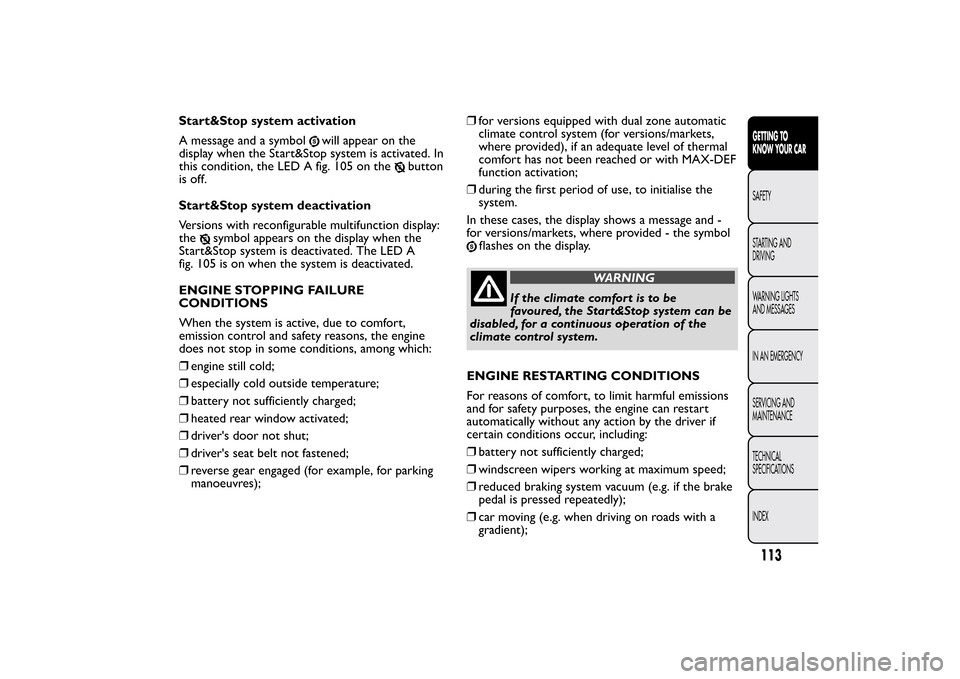
Start&Stop system activation
A message and a symbol
will appear on the
display when the Start&Stop system is activated. In
this condition, the LED A fig. 105 on the
button
is off.
Start&Stop system deactivation
Versions with reconfigurable multifunction display:
the
symbol appears on the display when the
Start&Stop system is deactivated. The LED A
fig. 105 is on when the system is deactivated.
ENGINE STOPPING FAILURE
CONDITIONS
When the system is active, due to comfort,
emission control and safety reasons, the engine
does not stop in some conditions, among which:
❒engine still cold;
❒especially cold outside temperature;
❒battery not sufficiently charged;
❒heated rear window activated;
❒driver's door not shut;
❒driver's seat belt not fastened;
❒reverse gear engaged (for example, for parking
manoeuvres);❒for versions equipped with dual zone automatic
climate control system (for versions/markets,
where provided), if an adequate level of thermal
comfort has not been reached or with MAX-DEF
function activation;
❒during the first period of use, to initialise the
system.
In these cases, the display shows a message and -
for versions/markets, where provided - the symbol
flashes on the display.
WARNING
If the climate comfort is to be
favoured, the Star t&Stop system can be
disabled, for a continuous operation of the
climate control system.
ENGINE RESTARTING CONDITIONS
For reasons of comfort, to limit harmful emissions
and for safety purposes, the engine can restart
automatically without any action by the driver if
certain conditions occur, including:
❒battery not sufficiently charged;
❒windscreen wipers working at maximum speed;
❒reduced braking system vacuum (e.g. if the brake
pedal is pressed repeatedly);
❒car moving (e.g. when driving on roads with a
gradient);
113GETTING TO
KNOW YOUR CARSAFETY
STARTING AND
DRIVING
WARNING LIGHTS
AND MESSAGES
IN AN EMERGENCY
SERVICING AND
MAINTENANCE
TECHNICAL
SPECIFICATIONS
INDEX
Page 118 of 299
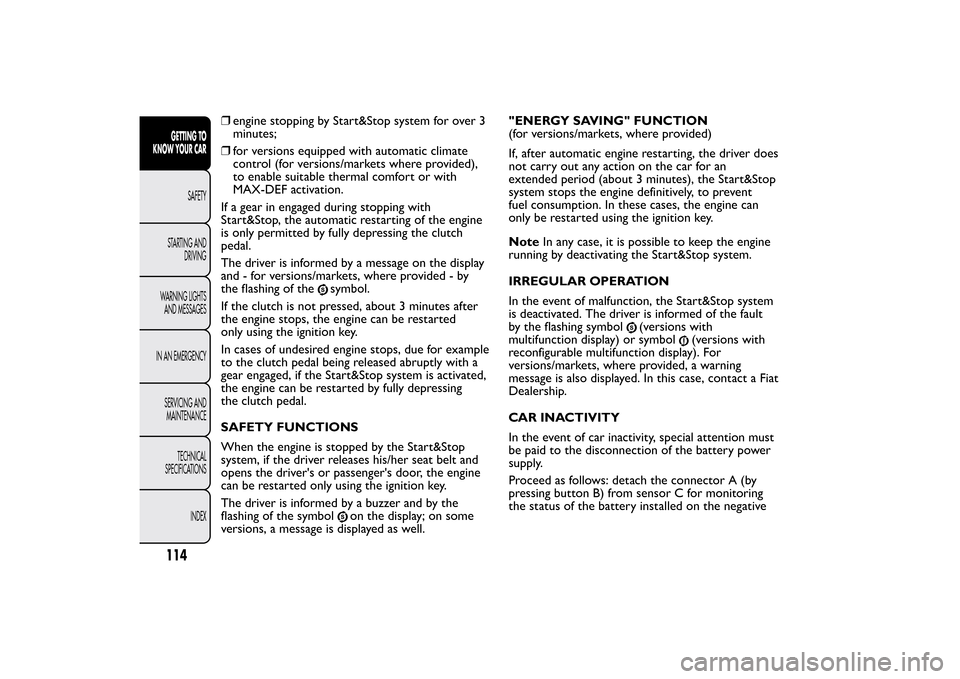
❒engine stopping by Start&Stop system for over 3
minutes;
❒for versions equipped with automatic climate
control (for versions/markets where provided),
to enable suitable thermal comfort or with
MAX-DEF activation.
If a gear in engaged during stopping with
Start&Stop, the automatic restarting of the engine
is only permitted by fully depressing the clutch
pedal.
The driver is informed by a message on the display
and - for versions/markets, where provided - by
the flashing of the
symbol.
If the clutch is not pressed, about 3 minutes after
the engine stops, the engine can be restarted
only using the ignition key.
In cases of undesired engine stops, due for example
to the clutch pedal being released abruptly with a
gear engaged, if the Start&Stop system is activated,
the engine can be restarted by fully depressing
the clutch pedal.
SAFETY FUNCTIONS
When the engine is stopped by the Start&Stop
system, if the driver releases his/her seat belt and
opens the driver's or passenger's door, the engine
can be restarted only using the ignition key.
The driver is informed by a buzzer and by the
flashing of the symbol
on the display; on some
versions, a message is displayed as well."ENERGY SAVING" FUNCTION
(for versions/markets, where provided)
If, after automatic engine restarting, the driver does
not carry out any action on the car for an
extended period (about 3 minutes), the Start&Stop
system stops the engine definitively, to prevent
fuel consumption. In these cases, the engine can
only be restarted using the ignition key.
NoteIn any case, it is possible to keep the engine
running by deactivating the Start&Stop system.
IRREGULAR OPERATION
In the event of malfunction, the Start&Stop system
is deactivated. The driver is informed of the fault
by the flashing symbol
(versions with
multifunction display) or symbol
(versions with
reconfigurable multifunction display). For
versions/markets, where provided, a warning
message is also displayed. In this case, contact a Fiat
Dealership.
CAR INACTIVITY
In the event of car inactivity, special attention must
be paid to the disconnection of the battery power
supply.
Proceed as follows: detach the connector A (by
pressing button B) from sensor C for monitoring
the status of the battery installed on the negative
114GETTING TO
KNOW YOUR CAR
SAFETY
STARTING AND
DRIVING
WARNING LIGHTS
AND MESSAGES
IN AN EMERGENCY
SERVICING AND
MAINTENANCE
TECHNICAL
SPECIFICATIONS
INDEX
Page 119 of 299
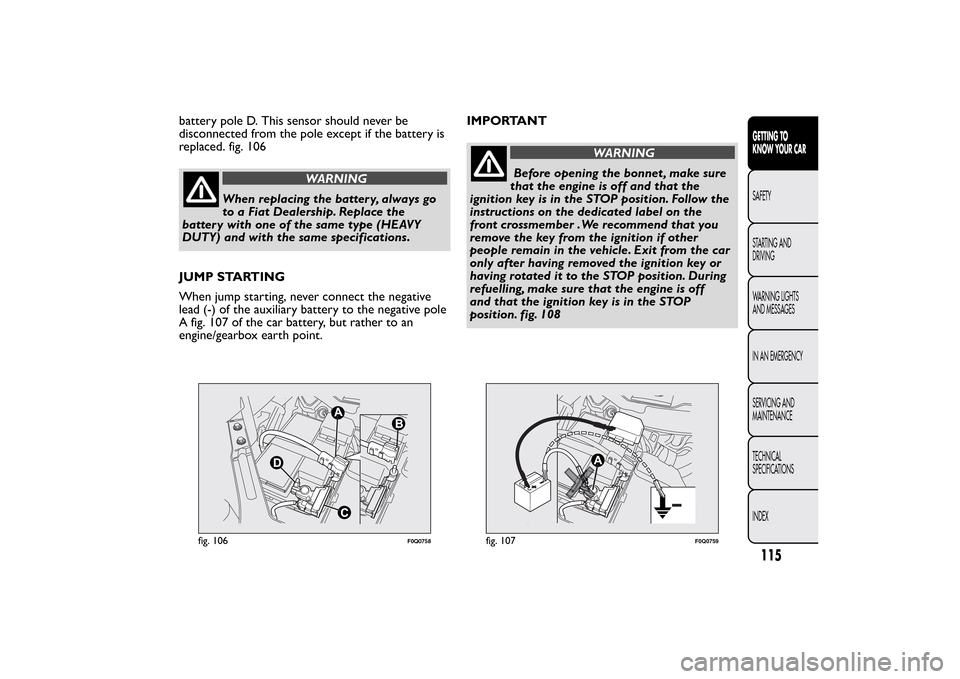
battery pole D. This sensor should never be
disconnected from the pole except if the battery is
replaced. fig. 106
WARNING
When replacing the batter y, always go
to a Fiat Dealership. Replace the
battery with one of the same type (HEAVY
DUTY) and with the same specifications.
JUMP STARTING
When jump starting, never connect the negative
lead (-) of the auxiliary battery to the negative pole
A fig. 107 of the car battery, but rather to an
engine/gearbox earth point.IMPORTANT
WARNING
Before opening the bonnet , make sure
thattheengineisoffandthatthe
ignition key is in the STOP position. Follow the
instructions on the dedicated label on the
front crossmember .We recommend that you
remove the key from the ignition if other
people remain in the vehicle. Exit from the car
only after having removed the ignition key or
having rotated it to the STOP position. During
refuelling, make sure that the engine is off
and that the ignition key is in the STOP
position. fig. 108
fig. 106
F0Q0758
fig. 107
F0Q0759
115GETTING TO
KNOW YOUR CARSAFETY
STARTING AND
DRIVING
WARNING LIGHTS
AND MESSAGES
IN AN EMERGENCY
SERVICING AND
MAINTENANCE
TECHNICAL
SPECIFICATIONS
INDEX
Page 120 of 299
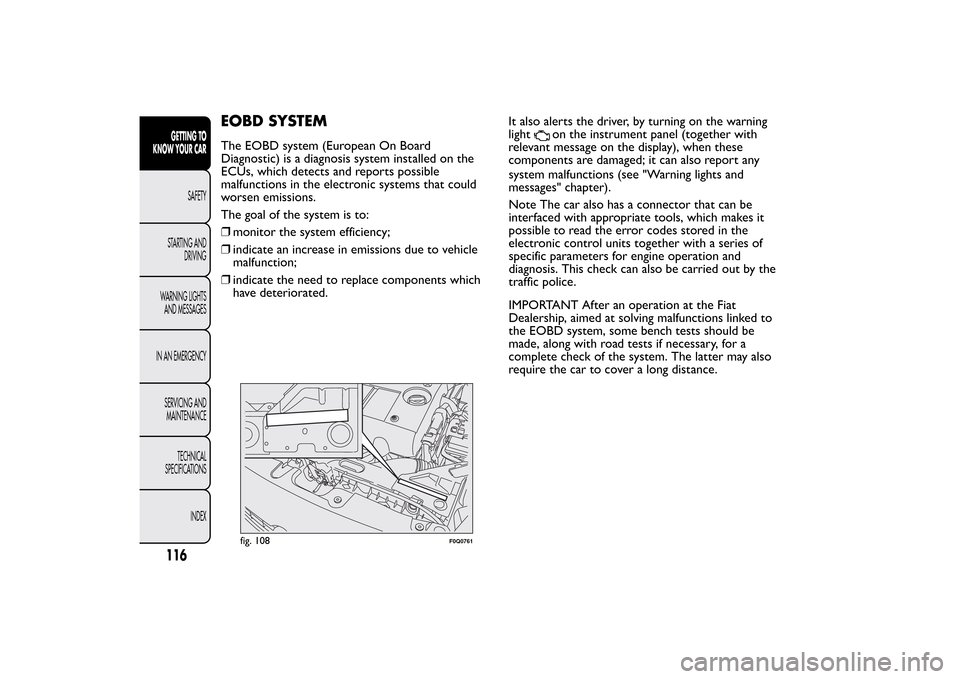
EOBD SYSTEMThe EOBD system (European On Board
Diagnostic) is a diagnosis system installed on the
ECUs, which detects and reports possible
malfunctions in the electronic systems that could
worsen emissions.
The goal of the system is to:
❒monitor the system efficiency;
❒indicate an increase in emissions due to vehicle
malfunction;
❒indicate the need to replace components which
have deteriorated.It also alerts the driver, by turning on the warning
light
on the instrument panel (together with
relevant message on the display), when these
components are damaged; it can also report any
system malfunctions (see "Warning lights and
messages" chapter).
Note The car also has a connector that can be
interfaced with appropriate tools, which makes it
possible to read the error codes stored in the
electronic control units together with a series of
specific parameters for engine operation and
diagnosis. This check can also be carried out by the
traffic police.
IMPORTANT After an operation at the Fiat
Dealership, aimed at solving malfunctions linked to
the EOBD system, some bench tests should be
made, along with road tests if necessary, for a
complete check of the system. The latter may also
require the car to cover a long distance.
fig. 108
F0Q0761
116GETTING TO
KNOW YOUR CAR
SAFETY
STARTING AND
DRIVING
WARNING LIGHTS
AND MESSAGES
IN AN EMERGENCY
SERVICING AND
MAINTENANCE
TECHNICAL
SPECIFICATIONS
INDEX